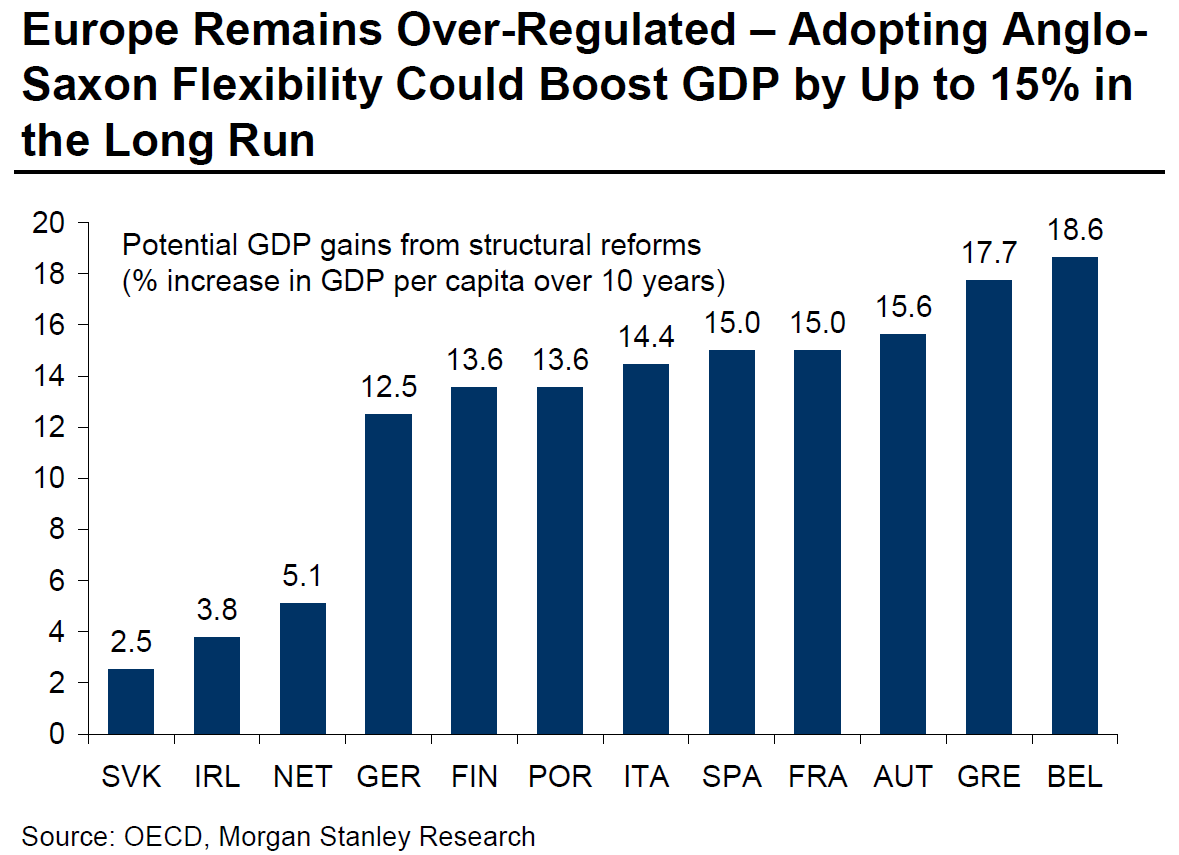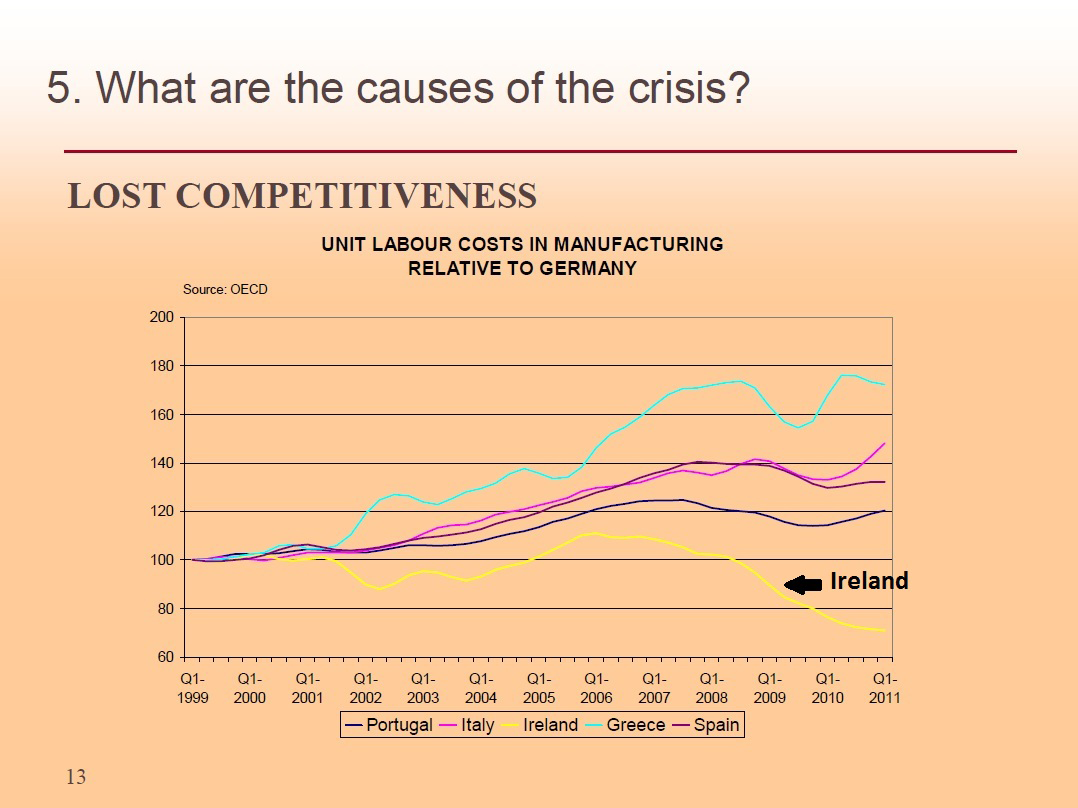As we await the results of the French and Greek elections, there has been a considerable change of focus in the eurozone from the paradigm of all-austerity-all-the-time to growth strategies. The villians, according to those who push back at the "fiscal compact", is Angela Merkel and, to a lesser extent, Mario Draghi.
What I don't get is that many analysts have failed to understand (see the post by Yves Smith as one example out of many) is that Draghi has said repeatedly said that the long-term plan has two components:
- "Good austerity" in the form of lower taxes and lower government spending. But the Grand Plan isn't all austerity, all the time. The second component addresses the problem of the competitiveness gap between northern and southern Europe, which means:
- Structural reform, which is the European version of the step China took to "smash the iron rice bowl" in order to create labor flexibility for all, not just the young but all of the current employees in their cushy jobs and gold-plated pension plans. Draghi went on to characterize structural reform as the old days of the European social model being all gone.
He talked about this in late February when he revealed the Grand Plan for the eurozone. He positioned structural reform as a "growth compact" when he spoke to the European parliament in late April. Last week, he went further when the Telegraph reported that ECB president Mario Draghi calls for binding 'growth pact':
The president of the European Central Bank (ECB) said it was of "utmost importance" for leaders to impose fiscal discipline but also to generate growth by "facilitating entrepreneurial activities, the start-up of new firms and job creation".
He echoed demands for a "growth pact" from leaders including the French presidential hopeful, Francois Hollande. But rather than protectionist policies advocated by some, Mr Draghi said his ideal growth pact would be based on free labour markets and structural reforms that would be "agreed collectively, not unlike the fiscal [pact]".
He said political commitment would be "the most important" part: "Collectively we have to specify the future of the euro; where do we want to be in 10 years' time?"
The "growth compact" in micro and macroeconomic terms
I feel that the market still doesn't really get Draghi's "growth compact". Let me try to explain it in micro and macroeconomic terms. In microeconomic terms, it addresses the barriers to business formation in many Club Med countries. Simply put, it's hard to fire people. The "growth compact" is an Anglo-Saxon, or Thatherite, solution to make it easier to terminate employees. This is what Draghi meant when he stated in the WSJ interview that "the European social model has already gone". His reasoning is illustrated by his response that the current arrangement is inherently unfair to the youth of Europe [emphasis added]:
WSJ: Which do you think are the most important structural reforms?
Draghi: In Europe first is the product and services markets reform. And the second is the labour market reform which takes different shapes in different countries. In some of them one has to make labour markets more flexible and also fairer than they are today. In these countries there is a dual labour market: highly flexible for the young part of the population where labour contracts are three-month, six-month contracts that may be renewed for years. The same labour market is highly inflexible for the protected part of the population where salaries follow seniority rather than productivity. In a sense labour markets at the present time are unfair in such a setting because they put all the weight of flexibility on the young part of the population.
The Anglo-Saxon reasoning goes, if it is easier to fire people and make them work harder or take away their gold plated pensions, it creates more opportunity for growth and business formation.
In microeconomic terms, the "growth compact" is structural reform, pure and simple. In macroeconomic terms, the "growth compact" means an internal devaluation by the peripheral countries in the eurozone, which is a fixed exchange rate regime. The Greeks, Italians, Spaniards, etc., just have to work harder and get paid less.
Projecting the gains under a "growth pact"
What are the possible gains under such an internal devalution? FT Alphaville reports that Morgan Stanley’s Joachim Fels and Elga Bartsch took a stab at the problem:
Morgan Stanley projects that the Club Med countries (which include France) could gain about 15% of GDP growth over 10 years if they adopted these structural reforms. This amounts to an average of 1.5% of GDP a year, which is considerable when you consider that the long-run real growth rate in Europe has been hovering around 2% per annum.
Martin Wolf of the FT showed some analysis in a presentation on May 3, 2012 to the National Economists Club and Petersen Institute for International Economics. My conclusion, in the context of the "growth compact", is that the Club Med countries should try to become more like Ireland.
Note how unit labor costs in the troubled peripheral countries have been rising relative to Germany - all except for Ireland. These structural reforms that make it easier to hire and fire people, or internal devaluation, could get unit labor costs down below German costs and make Greece, Spain, etc., look more like Ireland.
Also note from the first chart how low Morgan Stanley has projected Ireland's gains from structural reforms are, indicating that Dublin has already made the hard choices. This also means that Ireland will be the poster child for the growth pact and structural reform. The preliminary indications appear to be positive. This CNBC report discussing the upcoming Irish referendum on the fiscal compact shows that business are re-locating to Ireland "attracted by its relatively low corporation tax and increasingly cheap workforce":
Some of the forward-looking indicators for the Irish economy have been more positive. Tax revenues for March are 370 million euros ($486 million) ahead of target in the year to April 2012, driven by healthier corporation tax revenues as companies move to Ireland, attracted by its relatively low corporation tax and increasingly cheap workforce.
Nevertheless, I would expect that the trajectory of Irish growth will be scrutinized intensely to see if the harsh medicine is working.
A more realistic scenario
If all eurozone countries were to adopt the structural reforms that Draghi advocates and the Morgan Stanley analysis is correct, Germany would also gain 12.5% in GDP growth per annum. The spread between Spain and Germany is only 2.5% over 10 years, or 0.25% a year - hardly worthwhile.
Let us assume a more realistic scenario. Supposing that the peripheral countries were to adopt some form of structural reform, but only get two-thirds of the gains projected by Morgan Stanley, i.e. about 10% instead of 15% over 10 years. Assume, at the same time, that the Germans rest on their laurels. Indeed, former IMF chief economist Simon Johnson wrote in Bloomberg that German Unions Seeking Higher Pay Could Save the Euro [emphasis added]:
The solution involves a move straight out of the gold-standard playbook, with a modern twist. Since monetary union began, Germany has had substantial productivity gains and only moderate wage increases, making it highly competitive. Eurostat reports that German wages rose 2 percent a year from 2000 to 2009, while Spanish wages increased by 4.7 percent a year in the same period -- more than twice as fast. Because the currencies are the same, Germany’s competitiveness has made it tough for Spain and the other weaker states to sell their products in the euro area.
But the cavalry may show up in the unlikely form of German trade unions, which are seeking big wage increases this year. Recent demands by German workers range from 3 percent to 6 percent. As Bloomberg News reported, IG Metall, Europe’s biggest labor union with about 3.6 million workers, is demanding 6.5 percent more pay at a time when inflation is about 2 percent.
This isn’t crazy. German unemployment is at its lowest level in two decades. German exports have been doing well around the world. To some monetary purists, talk of higher wages suggests that the European Central Bank’s policy is too loose for current German conditions. But this is really taking an idealized version of the gold standard too far.
The point is to have relative wages and prices adjust -- higher for Germany and lower for its European trading partners. If German incomes rose, German consumers would have more disposable income with which to buy imported goods. And lower labor costs in other European countries would make their goods and services less costly, giving them a leg up against Germany’s export machine.
If the people in charge -- mostly Germans at this point -- insist that the adjustment must come entirely through a fall in the absolute level of wages and prices in countries with current-account deficits and large amounts of debt, then Europe is in for a difficult, and perhaps lost, decade.
But if part of the adjustment can come through higher German wages -- recognizing productivity gains and consistent with continued prosperity -- the path forward will be easier.
In other words, German wages go up while Club Med wages go down. Both Germany and the peripheral countries take actions to bear the cost of this internal devaluation.
The big question
Here is the big question. Assuming that the peripheral countries enact these structural reforms that make them more Anglo-Saxon. Would that create sufficient incentives for big employers like Alstom, EADS, BMW, Siemens to locate plants in Valencia, Thessaloniki or Lisbon, instead of looking at Poland or Slovakia as they do now?
I don`t know. What I do now is that the ECB has always had an agenda, or wish list as outlined by this analysis:
The ECB’s overarching goal is for the euro area’s politicians to establish credible European institutions working alongside the bank. It seeks, for example, bulletproof fiscal constraints on euro area members (something more credible than the Stability Growth Pact, which was widely ignored). It also wants a common euro area crisis fund to relieve the bank of the primary bailout responsibility. In addition, the ECB wants individual member states to accelerate structural reforms in their national economies.
To the extent that member states are willing to go along with the ECB, it has shown an inclination offer the carrot of supporting the harsh adjustments necessary with easy monetary policy and unconventional policies, such as LTRO. On the other hand, it has the stick that, if a member state were to falter, the ECB has the option of leaving that government to the mercy of the bond market wolves.
Draghi realizes that these prescriptions are harsh and that`s why he used the analogy of crossing the river in this report:
Structural reforms are essential to restoring competitiveness but will also cause pain in the short term, the ECB president said.
"Structural reforms hit vested interests," he said, adding that they "change profoundly the society." These changes are themselves "a source of pain," he added.
"We are just in the middle of the river that we are crossing. The only answer to this is to persevere and for the ECB to create an environment that is as favourable for this as possible," Draghi said.
Notwithstanding the news flow over the pending elections, the fight over austerity and structural adjustments is by no means over, regardless of the electoral outcome.
My bet, in the long run, is still on Draghi and Merkel. In the short run, however, anything can happen.
